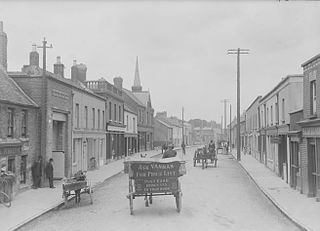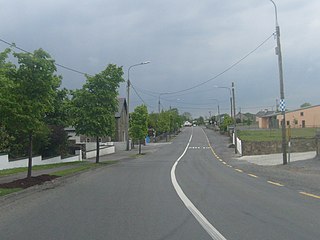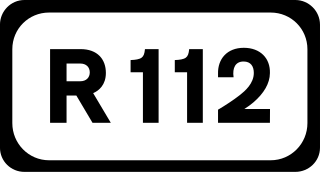
Rathfarnham is a southside suburb of Dublin, Ireland in County Dublin. It is south of Terenure, east of Templeogue, and is in the postal districts of Dublin 14 and 16. It is between the local government areas of Dún Laoghaire–Rathdown and South Dublin.

Tallaght is the largest settlement, and county town, of South Dublin, Ireland, and the largest satellite town of Dublin. The central village area was the site of a monastic settlement from at least the 8th century, which became one of medieval Ireland's more important monastic centres.

Templeogue is a southwestern suburb of Dublin in Ireland. It lies between the River Poddle and River Dodder, and is about halfway from Dublin's centre to the mountains to the south.

Ringsend is a southside inner suburb of Dublin, Ireland. It is located on the south bank of the River Liffey and east of the River Dodder, about two kilometres east of the city centre. It is the southern terminus of the East Link Toll Bridge. Areas included in Ringsend are the south side of the Dublin Docklands, and at the west end is the area of South Lotts and part of the Grand Canal Dock area. Neighbouring areas include Irishtown, Sandymount and the Beggars Bush part of Ballsbridge to the south, and the city centre to the west. A key feature of the area is the chimneys of Poolbeg power station.

The River Dodder is one of the three main rivers in Dublin, Ireland, the others being the Liffey, of which the Dodder is the largest tributary, and the Tolka.

Clonskeagh or Clonskea, is a small southern suburb of Dublin, Ireland. The district straddles the River Dodder.

Glenmalure Park, often simply known as Milltown, was a football stadium on the Southside of Dublin city in Ireland. Located in the suburb of Milltown, it was home to Shamrock Rovers from 1926 to 1987, when it was sold to property developers by the club's directors. It is now a housing estate called Glenmalure Square.

The Green Line is one of the two lines of Dublin's Luas light rail system. The Green Line was formerly entirely in the south side of Dublin city. It mostly follows the route of the old Harcourt Street railway line, which was reserved for possible re-use when it closed in 1958. The Green Line allows for passengers to transfer at O’ Connell GPO and Marlborough to Luas Red Line services and also allows commuters to use Broombridge as an interchange station to reach outer suburbs such as Castleknock and Ongar as well as Iarnrod Éireann services.

Dartry is a small suburb of Dublin, Ireland, often referred to as a corridor between Rathmines area and Milltown. Among the locations in Dartry are Dartry Road, Temple Road, Orwell Park and Palmerston Park.

Milltown is a small village in County Galway, Ireland. It is situated on the banks of the River Clare, 47 km from Galway City, 11 km from Tuam on the N17 road to Sligo.

The R112 road is a regional road in south Dublin, Ireland. It begins at the junction with the R148 road at Chapelizod and arcs southeastwards, then eastwards across the middle of south Dublin, ending at the Mount Merrion junction of the R138. The road is a single carriageway, with cycle lanes on some stretches. Improvements to the road have been made over the last 10 years, the most significant being at Dundrum Cross where the road was widened to make room for the new Luas bridge and Dundrum bypass.

The R825 road is a regional road in south Dublin, Republic of Ireland. The road starts in Clonskeagh at the junction with the R117 and passes through Goatstown, Kilmacud and Stillorgan before ending at a junction with the N31 in Blackrock, County Dublin. The route is 7.6 km (4.7 mi) in length and is single carriageway apart from a small 2 lane section beside the N11.

The R824 road is a regional road in south Dublin, Ireland. The road starts somewhere between Sandford and Clonskeagh, passes through Donnybrook and finishes at the junction with the Merrion Road and Ailesbury Road close by to Sydney Parade.

The River Slang, also known as the Dundrum Slang or the Dundrum River, a tributary of the River Dodder, is a stream which rises on Three Rock Mountain, County Dublin. It is in the local government area of Dún Laoghaire–Rathdown.

Clonskeagh Bridge is a bridge over the River Dodder in Dublin, Ireland. The bridge is on the Clonskeagh Road and forms part of the administrative boundary between Dublin City Council and Dún Laoghaire-Rathdown County Council

Classon's Bridge is a bridge over the River Dodder in Dublin, Ireland between Milltown and Dartry. The bridge is part of the Lower Churchtown Road (L3001) and has an underpass for pedestrians walking along the banks of the Dodder.

The Nine Arches Bridge is a viaduct over the River Dodder in Milltown, Dublin, Ireland. The Luas tram Green Line crosses the bridge. There is no access for pedestrians. The bridge is included on the Record of Protected Structures maintained by Dublin City Council.

Milltown is a stop on the Luas light rail tram system in Dublin, Ireland which serves Milltown, Dublin and southern parts of Dartry, including Trinity Hall. It opened in 2004 as a stop on the Green Line, which re-uses the alignment of the Harcourt Street railway line which closed in 1958. Milltown Luas stop is located a few yards north of the site of the former rail station of the same name.

Windy Arbour is a stop on the Luas light-rail tram system in Dún Laoghaire–Rathdown, south of Dublin, Ireland. It opened in 2004 as a stop on the Green Line from St Stephen's Green to Sandyford. It serves the suburbs of Windy Arbour, Churchtown, and Clonskeagh.





















